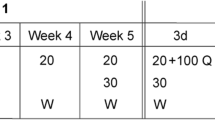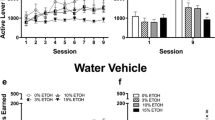Abstract
It has been previously suggested that drug-seeking behavior maintained by alcohol, opioids, and cocaine may have some common genetic determinants. Therefore, the present study examined the intake of etonitazene, a potent opioid agonist, and cocaine by alcohol-preferring AA (Alko, Alcohol), alcohol-avoiding ANA (Alko, Non-alcohol), and Wistar rats in a two-bottle choice test. The animals, housed in single cages, were given a choice between tap water and ascending concentrations of etonitazene (0.5, 1.0, 2.0, and 4.0 µg/ml) or cocaine (0.2, 0.4, 0.8, and 1.6 mg/ml) solutions prepared in water. Finally, to assess the sensitivity to bitter taste by these strains, a quinine preference test with ascending quinine concentrations was conducted. The clearest line differences were found with etonitazene: at all concentrations, the AAs consumed significantly more etonitazene than the ANAs and Wistars that showed no differences. The highest etonitazene intake by the AAs, 181 µg/kg/day at the concentration of 4.0 µg/kg, produced apparent signs of opioid intoxication and withdrawal. The AAs also drank more cocaine solution than the other lines. Since, however, the pattern of cocaine intake as a function of concentration resembled that with quinine, the line differences in cocaine consumption may partly be accounted for by the differential sensitivity to bitter taste by the lines. In contrast, the marked line differences in the intake of the etonitazene solutions, which had only a slightly bitter taste, seem more likely to have been produced by the post-ingestional effects of the opioid.
Similar content being viewed by others
References
Belknap JK (1990) Physical dependence induced by the voluntary consumption of morphine in inbred mice. Pharmacol Biochem Behav 35:311–315
Brown BS, Kozel NJ, Meyers MB, Dupont RL (1973) Use of alcohol by addict and nonaddict populations. Am J Psychiatry 130:599–601
Carney JM, Cheng MS, Wu C, Seale TW (1991) Issues surrounding the assessment of the genetic determinants of drugs as reinforcing stimuli. J Addict Dis 10:163–177
Eriksson CJP (1973) Ethanol and acetaldehyde metabolism in rat strains genetically selected for their ethanol preference. Biochem Pharmacol 22:2283–2292
Eriksson K (1968) Genetic selection for voluntary alcohol consumption in the albino rat. Science 159:739–741
Eriksson K, Kiianmaa K (1971) Genetic analysis of susceptibility to morphine addiction in inbred mice. Ann Med Exp Fenn 49:73–78
Forgie ML, Beyerstein BL, Alexander BK (1988) Contributions of taste factors and gender to opioid preference in C57BL and DBA mice. Psychopharmacology 95:237–244
George FR (1990) Genetic approaches to studying drug abuse: correlates of drug self-administration. Alcohol 7:207–211
George FR (1991) Is there a common biological basis for reinforcement from alcohol and other drugs? J Addict Dis 10:127–139
George FR, Goldberg SR (1988) Genetic differences in responses to cocaine. NIDA Monogr Ser 88:239–249
George FR, Goldberg SR (1989) Genetic approaches to the analysis of addiction processes. TIPS 10:78–83
George FR, Elmer GI, Meisch RA, Goldberg SR (1991) Orally delivered cocaine functions as a positive reinforcer in C57BL/6J mice. Pharmacol Biochem Behav 38:897–903
Horowitz GP, Whitney G, Smith JC, Stephan FK (1977) Morphine ingestion: genetic control in mice. Psychopharmacology 52:119–122
McMillan DE, Leander JD (1976) Schedule-induced oral self-administration of etonitazene. Pharmacol Biochem Behav 4:137–141
Meisch RA, Stark LJ (1977) Establishment of etonitazene as a reinforcer for rats by use of schedule-induced drinking. Pharmacol Biochem Behav 7:195–203
Meisch RA, George FR, Lemaire GA (1990) Orally delivered cocaine as a reinforcer for rhesus monkeys. Pharmacol Biochem Behav 35:245–249
Miller NS, Gold MS, Belkin BM, Klahr AL (1989) Family history and diagnosis of alcohol dependence in cocaine dependence. Psychiatr Res 29:113–121
Nichols JR (1972) Alcoholism and opiate addiction: theory and evidence for a genetic link between the two. In: Forsander O, Eriksson K (eds) Biological aspects of alcohol consumption. Finnish Foundation of Alcohol Studies, Helsinki, pp 131–134
Nichols JR, Hsiao S (1967) Addiction liability of albino rats: breeding for quantitative differences in morphine drinking. Science 157:561–563
Rosow CE, Miller JM, Pelikan EW, Cochin J (1980) Opiates and thermoregulation in mice. I. Agonists. J Pharmacol Exp Ther 213:273–283
Sala M, Braida D, Calcaterra P, Leone MP, Gori E (1992) Dose-dependent conditioned place preference produced by etonitazene and morphine. Eur J Pharmacol 217:37–41
Schmitz J, De Jong J, Garnett D, Moore V, Waxman R, Linnoila M (1991) Substance abuse among subjects seeking treatment for alcoholism. Arch Gen Psychiatry 48:182–183
Sinclair JD, Lê AD, Kiianmaa K (1989) The AA and ANA rat lines, selected for differences in voluntary alcohol consumption. Experientia 45:798–805
Sinclair JD, Kampov-Polevoy A, Stewart R, Li TK (1992) Taste preferences in rat lines selected for low and high alcohol consumption. Alcohol 9:55–160
Suzuki T, George FR, Meisch RA (1992) Etonitazene delivered orally serves as a reinforcer for Lewis but not Fischer 344 rats. Pharmacol Biochem Behav 42:579–586
Tang M, Falk JL (1987) Oral self-administration of cocaine: chronic excessive intake by schedule induction. Pharmacol Biochem Behav 28:517–519
Whitney G, Horowitz GP (1978) Morphine preference of alcohol-avoiding and alcohol-preferring C57BL mice. Behav Genet 8:177–182
Author information
Authors and Affiliations
Rights and permissions
About this article
Cite this article
Hyyatiä, P., Sinclair, J.D. Oral etonitazene and cocaine consumption by AA, ANA and Wistar rats. Psychopharmacology 111, 409–414 (1993). https://doi.org/10.1007/BF02253529
Received:
Revised:
Issue Date:
DOI: https://doi.org/10.1007/BF02253529




